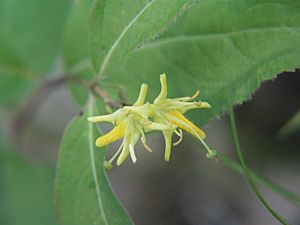Diervilla lonicera facts for kids
Quick facts for kids Diervilla lonicera |
|
|---|---|
 |
|
| Scientific classification | |
| Genus: |
Diervilla
|
| Species: |
lonicera
|
The northern bush honeysuckle (Diervilla lonicera) is a cool shrub that grows in the northeastern parts of the United States and Canada. You might also hear it called low bush honeysuckle or dwarf bush honeysuckle. Its scientific name, lonicera, sounds like "honeysuckle" because it looks a lot like the true honeysuckle plants. This plant is super important for bumblebees because its flowers provide them with lots of tasty nectar!
Contents
What is Northern Bush Honeysuckle?
The northern bush honeysuckle is a type of deciduous shrub. This means it loses its leaves every fall. It usually grows to be about 0.6 to 1.2 meters (2 to 4 feet) tall.
Key Features of the Plant
- It has branches that grow close to the ground.
- Its roots are strong and spread out.
- The flowers are a pretty pale yellow color.
- After the flowers, it grows dry, woody fruits.
- Its leaves are simple and grow in pairs opposite each other on the stem.
Seasonal Changes
The leaves of the northern bush honeysuckle change colors with the seasons. They start out green, then slowly turn a deep red. The yellow flowers bloom in summer, usually from early July to early August. By September, the seeds are ready to spread.
Where Does It Grow?
Northern bush honeysuckle likes to grow in places with rocks. It can handle cool weather and soils that are dry or not very rich in nutrients. You can often find it in forests where trees like balsam fir and jack pine grow.
Adapting to Its Home
This plant is very flexible! It doesn't care much if there's a lot of sunlight or not. This means it can live in many different kinds of places. It's also good at surviving fires. If a fire burns the plant above ground, it can quickly grow back from its underground stems. Scientists have seen it grow back strong even after big fires.
Where Can You Find It?
You can find northern bush honeysuckle all over North America. It grows along the entire east coast, from northern Quebec and Labrador down to Georgia and Alabama. It also reaches as far west as Saskatchewan in Canada. This plant was even brought to parts of Europe a long time ago, in the 1700s.
Why is it Important to People?
Plants from the honeysuckle family have been used for a long time in herbal medicine. People often use them to make herbal tea for sore throats. There are also recipes for cough syrup made from the leaves and flowers, mixed with honey. Some people say these homemade remedies work as well as store-bought medicines.
Important Safety Tip!
You can find these types of recipes online. However, it's super important to be careful! Some types of honeysuckle can be poisonous. So, you should never try to make these remedies yourself unless you are an expert. It's always best to be safe!
Why is it Important to Nature?
The northern bush honeysuckle is a great food source for many animals.
Food for Animals
- Moose eat the shrub and its fruit, especially in winter.
- White-tailed deer eat the plant in both summer and winter, but they like it best in late summer.
Helping Pollinators
This shrub is also very important for insects that help plants grow, like bumblebees. Its flowers are easy for bumblebees to reach and it produces many of them. This helps keep bumblebee populations healthy. It's also the only plant known to be a host for a special type of moth called the Hemaris aethra hawkmoth.
Home for Birds
Birds also use the northern bush honeysuckle. They often build their nests in its branches because it offers good protection. The fruits are also a ready food source for them. This plant might even help bird populations grow and spread to new areas!
Is it Endangered?
Northern bush honeysuckle is generally common and widespread across North America. It's only considered to be threatened in Tennessee and rare in Indiana. In most other places, including Canada, it is not on any threatened or endangered lists.

